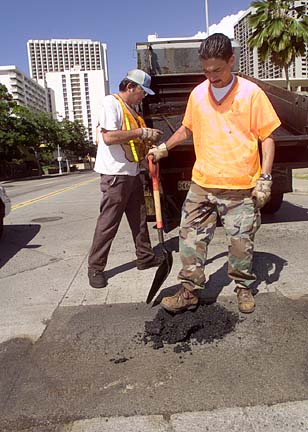


|
When pesky potholes proliferate after pouring rainfall, the public can call the city's Pothole Hotline or the state's Pothole Puka Patrol to report the problem. Oahu pothole patchers
put asphalt in its placeRoad crews work at keeping
the roads' complexion clearBy Pat Gee
pgee@starbulletin.comLast week's heavy downpours produced about double the number of potholes per day, or about 20, said Larry Leopardi, city Road Maintenance Division chief.
The downtown area reports the most potholes because of the high volume of traffic, he said.
The major thoroughfares, such as Dillingham Boulevard, King Street and University Avenue, which handle heavy vehicles like buses and trucks, also have a high number of holes, he added.
Priority is given to fixing the potholes in these high-traffic areas, and then the neighborhoods are taken care of, Leopardi said.
In dry weather, his crews repair about 10 a day, but after a heavy downpour, the number easily doubles, he estimated.
"People think asphalt is impervious to water, but it is not. When we get a lot of rain, it accelerates the formation of potholes. Fortunately we don't have the freeze/thaw cycle of colder climates," he said, explaining that water that freezes in cracks expands and "pops out more asphalt."
Martin Okabe, Oahu district engineer for the state Highways Division, said potholes could appear overnight if it rains heavily and puddles form. The standing water penetrates the surface of the asphalt, weakening the binding agent so that the asphalt crumbles; the loose pieces are whisked away by passing cars, thereby forming a pothole, he said.
Some holes have been as deep as one foot and as large as two feet in diameter. Priority is given to repair those that constitute a "real hazard" to drivers, Okabe said.
Potholes don't usually occur on the freeways, which are made of concrete, but on the asphalt roadways, he said.
If the city gets a call to repair a state road, it forwards the call to the state, and vice versa, both said.
The city has eight road crews, consisting of a driver and two road patchers, sent out daily to repair potholes throughout Oahu, Leopardi said. The state has a crew of eight to serve the entire island, according to Okabe.
The city's hot line is 527-6006; the state Pothole Puka Patrol's number is 536-7852.